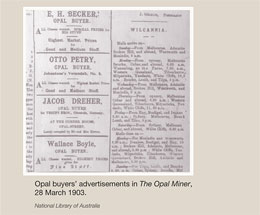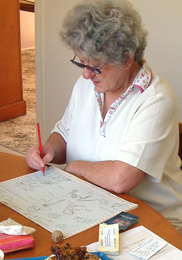| Lightning Ridge perspectives |
Jennifer Colless: A third generation perspective
From Germany and Ireland 1890s to Lightning Ridge 1909
There are wide, intriguing gaps in the biographical record of Jennifer’s grandparents, John and Catherine Francis. In working together, Jennifer and Mary came to some closer understandings of their movements and motives. The exhibition invited viewers to think about these too.
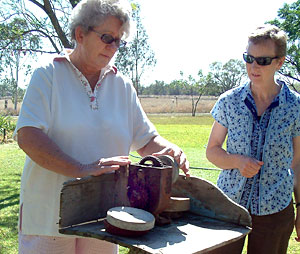 |
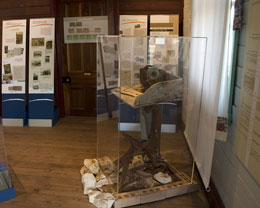 |
|
| Jennifer Colless showing her opal cutter to Mary Hutchison, Coolabong Station, 2005. Photograph: Jenni Brammall | Jennifer's story exhibited at Lightning Ridge. Photograph: Ursula Frederick |
Mapping the personal, the local and historical
The exhibition used maps, text and images to show the wider migration context of John and Catherine’s journeys from Germany and Ireland respectively, as well as their particular points of departure and destination. In Catherine’s case, there is also a final journey out of Australia.
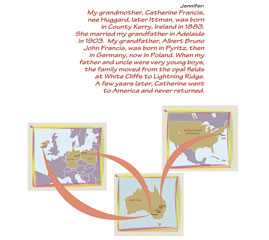 |
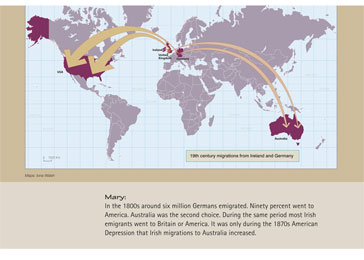 |
|
| Details from Migration Memories exhibition panel. Design: Iona Walsh. Click to enlarge. | ||
The local
Germany, and Germans like John Francis (Jennifer understands that his original surname was the German for ‘swan’) played an important role in the development of the Australian opal trade. Opal was sent to Germany for cutting and a number of German opal buyers set up business in the southern Australian cities and on the fields. When the White Cliffs fields started to fail at the turn of the century, finds at Lightning Ridge offered an alternative and many White Cliffs miners headed east – walking, cycling, on horseback or with horse and cart. John Francis was one of the few buyers who set up permanently in Lightning Ridge.
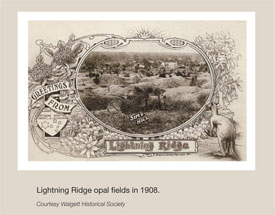 |
||
| Details from Migration Memories exhibition panel. Design: Iona Walsh. Click to enlarge. | ||
The page from The Opal Miner and the Lightning Ridge postcard featuring the site of one of the first big Lightning Ridge rushes, were two of the rare visual sources that Mary found to show the local opal fields world that John and Catherine were part of.
The personal in historical context
Personal histories can fill out the experience of general historical circumstances. John Francis was a German in Australia at a time when Australia’s relationship with Germany was breaking down. He and his sons stayed on in Lightning Ridge not only through the First World War in which Australia and Germany were enemies, and when many Germans living in Australia were interned, but also through the Great Depression which lasted from the late 1920s into the 1930s.
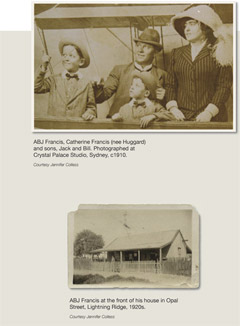 |
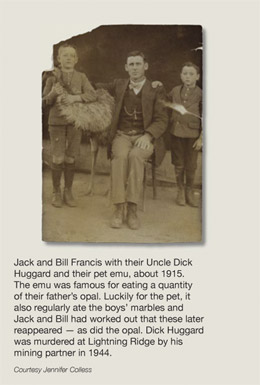 |
|
| Details from Jennifer Colless, panel three, Migration Memories: Lightning Ridge. Design: Iona Walsh. | ||
Historical context can also help make sense of personal decisions. Jennifer’s grandparents both came from regions where migration was often seen as an answer to lack of employment and opportunity. Like previous generations of migrants to Australia who had sought wealth through gold, they took their chances with opal. As Jennifer says, ‘It was a gambling family. They loved a good stone and they loved a good bet.’
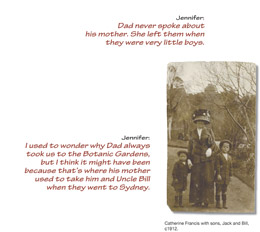 |
|
Detail from Jennifer Colless, panel four, Migration Memories: Lightning Ridge. Design: Iona Walsh. |
Eventually though, John and Catherine made different bets. In 1913 Catherine went to New York and never returned. Her two boys were 11 and 9 years old. Mary suggested that this decision might have had something to do with the hostility between Germany and Australia at the time, the role of America in the opal trade and its traditional place in the imagination of Irish emigrants. In the exhibition, the material was presented to invite audiences to think about the motives and issues behind Catherine’s second migration.
Looking back on the project
Mary
For Jennifer, the story of her grandparents is the beginning of the story of the Francis family in Lightning Ridge. My somewhat different focus on their migration histories fitted with Jennifer’s interest and introduced some new elements. In an interview with her about the experience of working on the exhibition she said, ‘You’ve opened up why he might have come out here and how many other German people went to America and Australia… It’s put more to the story in my head about my grandfather’.
Jennifer Colless drawing
the opal cutter. Photograph: Jenni Brammall, 2005. |
Jennifer
I thought it sounded very interesting but I thought I don’t know how she’s [Mary’s] going to attack this… but I thought I’m going to learn something…Just after our first couple of talks I thought well I don’t know how she’s going to get anything together here, at all, you know, and she’d come back with a little bit more, and another piece of paper to sign [laughter]. Then all of a sudden it just developed and I could see then what she was trying to do… I’ve enjoyed every bit of it.

